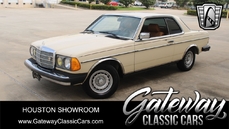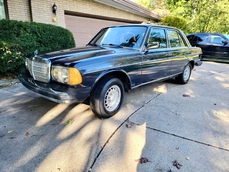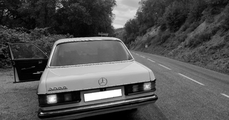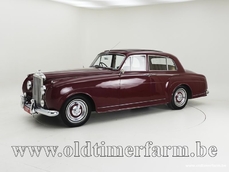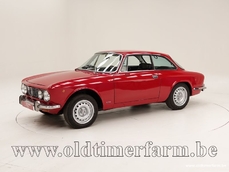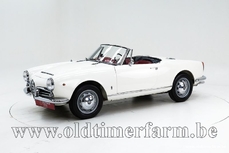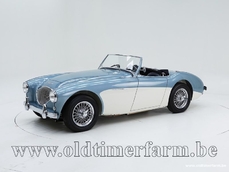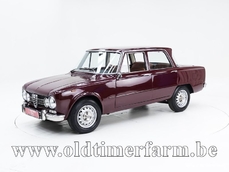Mercedes-Benz 300D w123 1958
General description :
Lowered price from €51.950 -> €42.000Swedish origin.Only 3077 were produced.Very rare.Good conditionWell maintained.The Mercedes-Benz Type 300 (chassis codes W186, W188, and W189) were the company's largest and most-prestigious models throughout the 1950s. Analogous to the top of today's S-Class, the Type 300 cars were elegant, powerful, exclusive, and expensive. Two types were produced, a four-door tourer equal in luxury and price but superior in performance to the rival Rolls-Royce Silver Cloud, and and an all but handbuilt two-door sports tourer rarified in elegance, proportion, and cost. The four-door 300, 300b, 300c (chassis code 186), and successor 300d (chassis code 189) models were often referred to as Adenauers after Konrad Adenauer, the first Chancellor of the Federal Republic of Germany. In office from 1949 to 1963, he employed six custom convertible, hardtop, and landaulet versions during his tenure. These large saloons and cabriolets incorporated many luxury features. Options such as Becker radio, VHF mobile telephone, and dictation machine were geared to the business man and politician. Among the custom features in Chancellor Adenauer's "parade cars" were writing desks, sirens, curtains, dividing partitions, sunroofs, and half-roof landaulet configurations. The exquisite two-door 300s (chassis code 188) and its successor 300Sc were the pinnacles of the Mercedes line of their era. Each were available in 2+2 coupe, cabriolet, and roadster versions. Introduced in August 1957, the 300d was the linear successor to the 300c, with a longer wheelbase, fuel injection, and unique hardtop configuration transforming it into a pillarless phaeton. An additional 4 inches of wheelbase provided greater rear legroom equaling that of the long wheelbase model Rolls-Royce Silver Cloud. Removable rear quarter lights allowed an unobstructed view in and out from the front vent window on back, much valued in the model's popular role as "parade car". Employing a slightly detuned version of the 300 SL sports car's Bosch fuel injected engine, the 300d produced 180 PS (130 kW; 180 hp) at 5500 rpm. Automatic transmission was standard. Power brakes, power steering, and Artic-Kar air-conditioning were added as an options. A total of 3,077 300d models (priced at DM 27,000) was produced through March 1962, along with 65 special-order 300d-based Cabriolet Ds (DM 35,500). After some initial overlap with the smaller, more contemporary styled W112 chassied 300SE, the 300d was ultimately replaced as M-B flagship by the 600 pullman "Grand Mercedes".Specifications Bodywork Length : cm (in): 519 (204) Width : cm (in): 186 (73.2) Height : cm (in): 162 (63.8) Wheelbase : cm (in) : 315 (124) Weight: kg (lb) : 1950 (4299) Mechanics. Displacement : straight six 2996 cc (182.2 ci) Valve gear : 12 Fuel system : Bosch mecanical injection Gearbox : 3 speed automatic Drive wheels : rear wheel drive Maximum power : 158 bhp at 5300 rpm Maximum torque : 237 Nm at 4200 rpm Maximum speed : 170 km/h (106 mph) For more pictures scroll down! >>>>>>Oldtimerfarm specializes in consignment sales of vintage and collection cars and we are proud to present you this car. Oldtimerfarm is located in Belgium, 9880 Aalter, Steenweg op Deinze 51C, where this car is in our showroom. We are open from Tuesday to Saturday 10-17h (also without appointment). We are closed on Sundays and Mondays. Mondays on appointment only. Make sure you scroll down to look at the extensive photo report (100 pictures). Of course, a more detailed description can be obtained by telephone.Contact us:Xavier: 0032 472 40 1338 (NL, FR, DE, EN, IT) info@oldtimerfarm.be Olivier: 0032 473 11 7300 (NL, FR, DE, EN) olivier@oldtimerfarm.beOldtimerfarm from Aalter would also like to sell your classic car or car collection. For more information, please contact Xavier.Exhibitions where you can find us: 11-12/02/2017 Flanders Collection Car Gent- Belgium02-05/03/2017 Retro Classics Stuttgart - Germany03-05/03/2017 Antwerp Classic Salon - Belgium05-09/04/2017 Techno Classica Essen - Germany28/04-01/05/2017 Open doors Oldtimerfarm01-03/09/2017 Open doors Oldtimerfarm
http://www.oldtimerfarm.be/en/collection-cars-for-sale/3175/mercedes-benz-300d-adenauer-58.php
1958 Mercedes-Benz 300D w123 is listed sold on ClassicDigest in Aalter by Oldtimerfarm Dealer for €42000.
Car Facts
Car type : Car Make : Mercedes-Benz Model : 300D w123 Engine size : 0.0 Model Year : 1958 Location : Aalter Vehicle Registration : Normal
Sold
Seller Information
Sold
People who viewed this Mercedes-Benz 300D w123 also viewed similar Mercedes-Benz listed at ClassicDigest
Other cars listed for sale by this dealer
About Mercedes-Benz
In the annals of automotive history, the journey of Mercedes-Benz is a tale that unfolds with the ingenuity of its founding pioneers. In the year 1886, Karl Benz crafted the Benz Patent Motorwagen, a creation that would go down in history as the world's inaugural automobile. Unbeknownst to him, this moment marked the genesis of what would evolve into the most illustrious premium car manufacturer globally. The financial underpinning of this pioneering venture, interestingly, was provided by Karl Benz's wife, Bertha Benz, demonstrating a remarkable partnership that would set the tone for Mercedes-Benz's legacy.A parallel narrative emerged not far away, as Daimler-Motoren-Gesellschaft, founded by Gottlieb Daimler and Wilhelm Maybach, entered the scene. In 1901, they unveiled their automobile under the now-famous moniker "Mercedes," meaning "godsend" in Spanish. This name was bestowed upon the car at the behest of Emil Jellinek's daughter, the distributor for Daimler-Motoren-Gesellschaft. The wheels of innovation were set in motion.
Fast forward to 1926, a pivotal year that witnessed the merger of Daimler with Benz & Cie., culminating in the birth of Daimler-Benz. The amalgamation saw the adoption of "Mercedes-Benz" as the distinguished trademark for their automobiles, fusing the legacies of two visionary entities into one.
Contrary to perceptions of conservatism, the trajectory of Daimler-Benz unfolds as a chronicle of industry firsts. From the introduction of the honeycomb radiator to the float carburetor, and the pioneering implementation of four-wheel brakes in 1924, Daimler-Benz consistently pushed the boundaries of automotive innovation. The diesel-powered Mercedes-Benz 260 D in 1936 marked the inception of diesel engines in passenger cars. The iconic Mercedes-Benz 300SL Gullwing made history as the first car with direct fuel injection, albeit the Gutbrod's tiny 2-stroke engine can claim precedence.
Safety innovations became a hallmark, with Béla Barényi's patented safety cell design in the "Ponton"-models in 1951, featuring front and rear crumple zones. The W116 450SEL 6.9 saw the introduction of the Anti-Lock Brake system (ABS), another pioneering safety feature. From the first production airbags and beyond, the legacy of "firsts" continued to be etched into the fabric of Daimler-Benz.
Over its centennial journey, Mercedes-Benz has not merely produced cars but has sculpted automotive icons. The SSKL, 710 SSK Trossi Roadster, 770K Grosser, 540K Spezial Roadster, 300SL Gullwing, w100 600 Pullman, w111 280SE 3.5 Flachkühler, w113 230SL Pagoda, w109 300 SEL 6.3, and w201 2.3-16 Cosworth stand testament to the brand's commitment to engineering excellence.
The roaring Silver Arrows, or "Silberpfeile," including the W 25, W 125, W154, W165, and W196, created a legacy of dominance on the racetrack. These machines were not merely cars; they were expressions of precision, speed, and an indomitable spirit that left their competitors in the dust.
As Mercedes-Benz marches into the future, it does so not just as an automaker but as a custodian of a legacy, a torchbearer of innovation, and a beacon of automotive excellence. The road ahead is sure to witness the continued fusion of cutting-edge technology, timeless design, and an unwavering commitment to setting new standards in the world of automobiles.
One luminary figure who left an indelible mark was Béla Barényi, often heralded as the "father of passive safety" for his pioneering work in safety engineering. His patented safety cell design, featuring front and rear crumple zones, became a hallmark of Mercedes-Benz's commitment to occupant safety, setting new standards that reverberated throughout the automotive world.
Moving through the chronicles, the collaborative genius of Wilhelm Maybach, alongside Gottlieb Daimler, laid the foundation for Daimler-Motoren-Gesellschaft. Their innovations not only birthed the first Mercedes but established a culture of relentless pursuit of technological excellence that remains integral to Mercedes-Benz's DNA.
In the post-merger era of 1926, Ferdinand Porsche emerged as a prominent figure within Mercedes-Benz. His work on the Mercedes-Benz S-Type, a supercharged race car, garnered acclaim and set the stage for a legacy that extended far beyond the marque. Porsche's impact would later extend to his eponymous company, but his influence at Mercedes-Benz during those formative years was pivotal.
As the 20th century progressed, the legendary Rudolf Uhlenhaut emerged as a key figure. Uhlenhaut, an accomplished engineer and the driving force behind the iconic Silver Arrows, played a crucial role in Mercedes-Benz's dominance in motorsports. His engineering prowess and attention to detail were instrumental in creating some of the most formidable racing cars of the era.
In the latter half of the century, figures like Bruno Sacco, the head of design at Mercedes-Benz from 1975 to 1999, left an indelible imprint on the brand's aesthetic identity. Sacco's design philosophy, characterized by clean lines and timeless elegance, shaped iconic models like the W126 S-Class and the W201 190E, solidifying Mercedes-Benz's reputation for luxury and sophistication.
The narrative would be incomplete without acknowledging the contributions of engineers like Hans Scherenberg, whose leadership in the 1970s ushered in a new era of technological innovation at Mercedes-Benz. Scherenberg's tenure saw the development of groundbreaking technologies, including the Anti-Lock Brake system (ABS) and the introduction of airbags in production cars.



